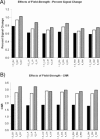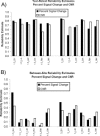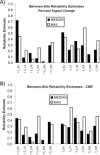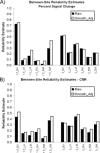Test-retest and between-site reliability in a multicenter fMRI study
- PMID: 17636563
- PMCID: PMC3670112
- DOI: 10.1002/hbm.20440
Test-retest and between-site reliability in a multicenter fMRI study
Abstract
In the present report, estimates of test-retest and between-site reliability of fMRI assessments were produced in the context of a multicenter fMRI reliability study (FBIRN Phase 1, www.nbirn.net). Five subjects were scanned on 10 MRI scanners on two occasions. The fMRI task was a simple block design sensorimotor task. The impulse response functions to the stimulation block were derived using an FIR-deconvolution analysis with FMRISTAT. Six functionally-derived ROIs covering the visual, auditory and motor cortices, created from a prior analysis, were used. Two dependent variables were compared: percent signal change and contrast-to-noise-ratio. Reliability was assessed with intraclass correlation coefficients derived from a variance components analysis. Test-retest reliability was high, but initially, between-site reliability was low, indicating a strong contribution from site and site-by-subject variance. However, a number of factors that can markedly improve between-site reliability were uncovered, including increasing the size of the ROIs, adjusting for smoothness differences, and inclusion of additional runs. By employing multiple steps, between-site reliability for 3T scanners was increased by 123%. Dropping one site at a time and assessing reliability can be a useful method of assessing the sensitivity of the results to particular sites. These findings should provide guidance toothers on the best practices for future multicenter studies.
Figures








References
-
- Benjamini Y, Hochberg Y ( 1995): Controlling the false discovery rate: A practical and powerful approach to multiple testing. J R Stat Soc B 57: 289–300.
-
- Charter RA ( 1999): Sample size requirements for precise estimates of reliability, generalizability, and validity coefficients. J Clin Exp Neuropsychol 21: 559–566. - PubMed
-
- Cicchetti DV ( 2001): The precision of reliability and validity estimates re‐visited: Distinguishing between clinical and statistical significance of sample size requirements. J Clin Exp Neuropsychol 23: 695–700. - PubMed
-
- Cicchetti DV, Sparrow SA ( 1981): Developing criteria for establishing interrater reliability of specific items: Applications to assessment of adaptive behavior. Am J Ment Defic 86: 127–137. - PubMed
Publication types
MeSH terms
Grants and funding
LinkOut - more resources
Full Text Sources
Medical

